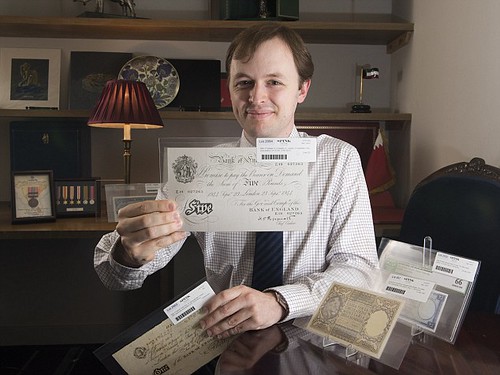
PREV ARTICLE
NEXT ARTICLE
FULL ISSUE
PREV FULL ISSUE
POLYMER ADVENT DRIVES INTEREST IN OLDER BANKNOTES
Banknote dealers Andrew Pattison and Pam White were interviewed in this article about the resurgence of interest in collecting old
British banknotes brought about by the shift to the new polymer notes. -Editor

Andrew Pattison with a 'White Fiver' from 1944 The old paper £5 is being replaced with a plastic note from next month – a move that should renew collector interest in rare early fivers. The new note is made of a polymer, not paper, and should be harder to forge or accidentally destroy. Late 18th and early 19th Century fivers are rare – most people of this time never saw paper money in an era when average earnings were less than £20 a year. Today, if you stumble across one of these early so-called ‘White Fiver’ notes it may be worth £10,000 or more. They were printed on white paper and individually signed. The notes were about twice the size of the new plastic one that will be just five inches wide – 15 per cent smaller than the current fiver. Andrew Pattison, banknote specialist for international auction house Spink, says: ‘There has been a real surge of interest in collecting old banknotes in the past few years. This new £5 may help to boost their appeal.’ He points out that the British fiver was produced in black ink on white paper until 1956. A year later, the first blue note was released along with pictures – Britannia on one side and a lion on the back. These notes are known as the ‘Lion & Key’ or ‘Helmeted Britannia’ and were legal tender until 1967. Pattison says: ‘Although the early notes may not always be interesting to look at, this does not affect their price – it is the history behind them that creates the value.’ Among his favourites is a 1914 fiver that belonged to Lord Montagu of Beaulieu who was a passenger on the SS Persia that was torpedoed by a German submarine in December 1915 during the First World War. Fortunately, the owner survived – though sadly his mistress Eleanor Thornton did not. Thornton’s figure is immortalised as the model behind the ‘Spirit of Ecstasy’ that adorns all Rolls-Royce car bonnets. Pattison says: ‘Lord Montagu was in the water for 32 hours before being rescued. He later wrote a letter to the banknote manufacturer Portals congratulating it on the quality of its paper. ‘Unlike other papers he had been carrying at the time, the banknote survived. We sold it two years ago for £800.’ Pattison points out that the first couple of new notes issued are historically given to the Queen – so she will be the first to have plastic fivers in her purse. Pam West, dealer at Pam West British Notes in Sutton, Surrey, believes collectors should invest in the best quality notes that they can afford. She says: ‘The last white fiver was issued in December 1956 and remained legal tender until 1961. Top quality examples from the 1950s can sell for £300 but if well used they will fetch less than £100. A good place for note collectors to start is to dig out a copy of English Paper Money by Vincent Duggleby, edited by Pam West. The book is currently out of print but a new edition is due out early next year. To read the complete article, see:
Wayne Homren, Editor The Numismatic Bibliomania Society is a non-profit organization promoting numismatic literature. See our web site at coinbooks.org. To submit items for publication in The E-Sylum, write to the Editor at this address: whomren@gmail.com To subscribe go to: https://my.binhost.com/lists/listinfo/esylum All Rights Reserved. NBS Home Page Contact the NBS webmaster 
|